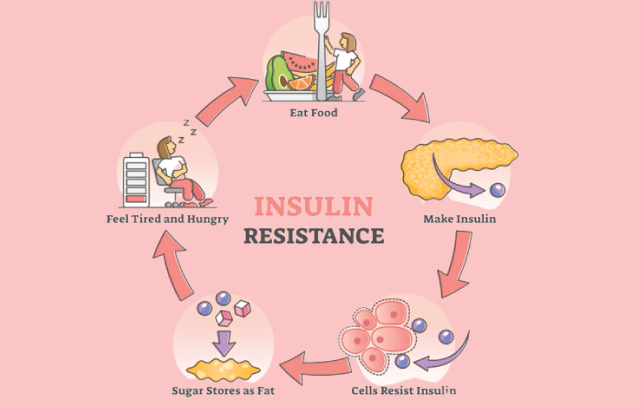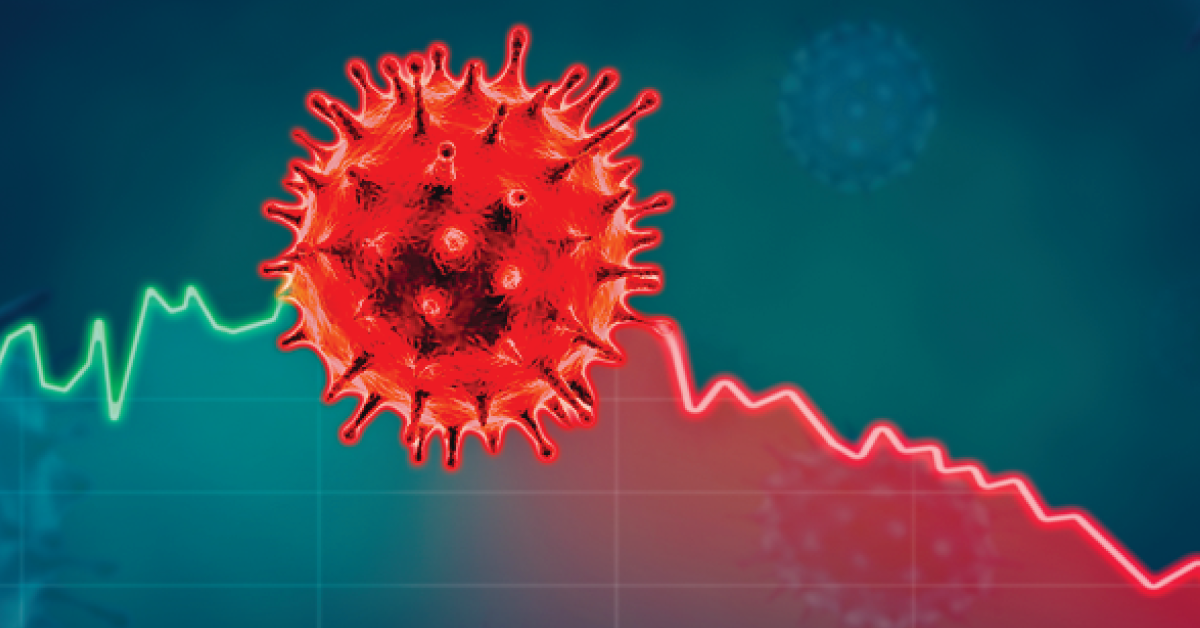
The pancreas produces the hormone insulin, which enables cells to take up and utilize glucose. Cells are unable to utilize insulin adequately in persons with insulin resistance. You must take the guidance of a diabetologist or general physician for more clarity on the topic of insulin resistance.
Glucose, often known as blood sugar, builds up in the blood when the cells are unable to absorb it. Doctors refer to this condition as prediabetes if blood glucose levels are higher than normal but not high enough to suggest diabetes. You can take the help of a diabetologist to understand it better. A good diet plan in insulin resistance will pave out an easy way for quick relief. The causes of insulin resistance are many and have a complete look into the article to know about the same.
People with significant levels of insulin resistance frequently develop prediabetes. According to data from the Centers for Disease Control and Prevention, approximately 1 in 3 Americans have prediabetes (CDC). People who have a diet plan in insulin resistance recover from it quickly. A diabetologist can help you in making a good diet plan for insulin resistance. You can also seek the help of online consultation for more insights into the causes of insulin resistance.
The understanding of insulin resistance as a risk factor for diabetes and other diseases is examined in this article. We also go over the indicators and symptoms. Once you have read this article completely, you can seek the help of online consultation or consult any general physician for more help.
What is Insulin Resistance?
When cells in the body don’t react effectively to insulin’s signals for communication, that condition is known as insulin resistance.
As a result, there is a higher chance of getting prediabetes and ultimately type 2 diabetes. The causes of insulin resistance are related to many factors.
Diabetes is less likely to occur and blood glucose levels will remain within a safe range if the pancreas can produce enough insulin to compensate for the reduced rate of absorption.
How can diabetes result from insulin resistance?
The pancreas works harder and harder in a person with prediabetes to produce enough insulin to overcome the body’s resistance and control blood sugar levels.
Type 2 diabetes can arise as a result of the pancreas’ gradual loss of its capacity to secrete insulin.
Type 2 diabetes continues to be characterized by insulin resistance.
Insulin intolerance and diabetes
The quantity of glucose circulating in the blood is controlled by insulin. It promotes the absorption of glucose by the cells, which originates from the food that people ingest.
Additionally, insulin is the chemical signal that tells the liver to keep some glucose instead of releasing it into the blood. Glycogen, a form of storage for glucose, is packaged by the liver.
Insulin typically aids the body in maintaining a healthy energy balance by preventing prolonged spikes in blood sugar.
Researchers are still looking at the complicated causes of insulin resistance.
According to a reliable source, we currently understand the following about how insulin resistance arises:
- Insulin no longer adequately supports bodily cells.
- The pancreas initially secretes more insulin to keep blood sugar levels healthy.
- To counteract the cells’ rising resistance, the pancreas can no longer sustain the secretion of further insulin.
- When blood sugar levels become consistently high, type 2 diabetes and prediabetes may occur if the person is unable to maintain their blood sugar levels and obtain treatment.
Symptoms of Insulin Resistance
Diabetes typically develops before symptoms of insulin resistance appear. According to the CDC, more than Trusted Source 85 percent of persons with prediabetes are likely not aware that they have the illness. Once you see any of the symptoms of insulin resistance, consult a diabetologist immediately for knowing the causes of insulin resistance.
The following health conditions and insulin resistance are also connected:
- Acanthosis nigricans: Those who have insulin resistance may acquire this skin disorder. Armpits, the back of the neck, and the groin develop thick, velvety patches. Depending on a person’s skin tone, increased pigmentation may result in darker skin.
- Insulin resistance and polycystic ovarian syndrome (PCOS) are associated with one another. Menstrual cycle irregularities, infertility, and painful periods are all possible signs of PCOS.
- A person with high blood insulin levels may also have vascular disease.
- High blood insulin levels are also linked to an increased risk of major depressive disorder (MDD), even in the absence of diabetes. reputable source for information on serious depression.
A test for insulin levels and insulin resistance may be considered if someone is worried about these diseases. It is always preferred to consult a diabetologist if you see any of the symptoms of the insulin resistance.
Risk Factors in Insulin Resistance
The subsequent Risk factors for insulin resistance, prediabetes, and diabetes are as follows:
- Having a sedentary or inactive lifestyle.
- Being overweight or obese, especially if the excess weight is around the midriff.
- Smoking, drinking excessive amounts of alcohol, which can harm the liver, and having sleep problems
- Having high blood pressure, which a 2018 study Trusted Source ties to an increased risk of insulin resistance, having high cholesterol levels.
Diabetes, prediabetes, and other cardiovascular and cerebrovascular conditions including stroke all share some risk factors with heart disease.
These risk factors cannot always be prevented, although some of them might be. Doctors advocate lifestyle changes because they can help lower the risk of the illness. You can also take the help of online consultation for having a more clear understanding on the same.
Everyone over the age of 45 should get tested for diabetes, according to the Department of Health and Human Services.
Additionally, it advises testing if someone is under 45 and:
- Has high cholesterol and is overweight or obese
- Has a history of gestational diabetes or delivered a baby weighing more than two kilogrammes.
- Is of African American, Asian American, Latino or Hispanic American, Native American, or Pacific Islander descent.
Tests for insulin resistance and diagnosis
Several tests can be used to identify diabetes and prediabetes:
- An individual’s average blood sugar level over the previous three months is determined by the A1C test. This is beneficial in knowing the causes of insulin resistance also.
- During a fasting blood glucose test, a patient is examined after going without food or liquids for at least eight hours.
- Random glucose test: This entails a doctor measuring your blood sugar levels at random times throughout the day.
- Usually, multiple of these tests are ordered by doctors in order to get a precise diagnosis.
If blood sugar levels frequently go outside of the usual range, the body may be developing insulin resistance.
Prevention
Some risk factors for insulin resistance and type 2 diabetes, like genetics and family history, cannot be changed.
One can, however, take some measures to lessen their risk of acquiring insulin resistance. You can take online consultation help from any diabetologist or family physician for more tips.
Similar tactics, like controlling your weight or giving up smoking, are essential for preventing heart disease and stroke. According to experts, these steps can delay the onset of diabetes in up to 50% of prediabetic individuals.
A person who is overweight or obese can greatly lower their risk of acquiring diabetes by losing 5-7 percent of their body weight, according to the CDC.
Exercise is also beneficial. After exercise, muscles become more insulin-sensitive, which aids the body in reversing insulin resistance. Making a diet plan in insulin resistance will help the people who have the causes of insulin resistance. The general physician will also help in drafting a diet plan.
Diet Plan in Insulin Resistance
You run a higher chance of getting type 2 diabetes and prediabetes if you have insulin resistance. An early warning indicator is also receiving an insulin resistance diagnosis. You must have a proper diet plan in insulin resistance.With a healthy lifestyle that includes regular exercise and a well-balanced diet, you may be able to prevent diabetes.
In general, it’s recommended to select whole, unprocessed foods and stay away from prepared and highly processed foods.
The diet plan in insulin resistance is discussed here. High-processed foods, like white bread, pasta, rice, and soda, digest fast and can cause blood sugar levels to increase. The pancreas, which produces the hormone insulin, is under additional strain as a result.
If you have insulin resistance, your body prevents the insulin from lowering your blood sugar levels as it should.
Conclusion
Type 2 diabetes is characterized by insulin resistance, which can also be present in people with prediabetes.
The body needs insulin to use glucose efficiently and keep blood sugar levels from becoming out of control. Diabetes may occur if insulin does not function properly and blood sugar levels rise.
By making lifestyle changes to combat insulin resistance and the early onset of diabetes, many persons with prediabetes can avoid acquiring type 2 diabetes.

